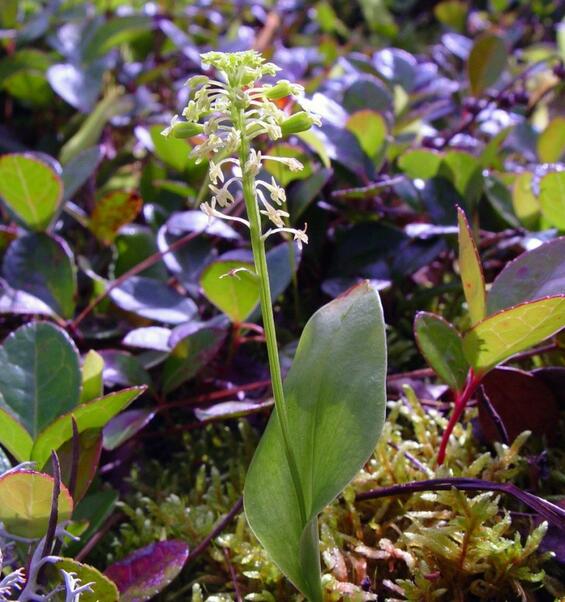- Scientific name: Malaxis unifolia Michx.
- Species of Greatest Conservation Need (MA State Wildlife Action Plan)
- Threatened (MA Endangered Species Act)
Description

Green adder’s-mouth (Malaxis unifolia) is a small, pale green orchid (family Orchidaceae), known from a variety of forest and wetland habitats throughout eastern and central North America. It is often an inconspicuous plant, 3-23 cm (~1.2-9 in) in height, but it can grow to 50 cm (~20 in). Distinctive features include a cylindrical raceme of 10 to 100+ tiny green flowers, and one bright green stem leaf, from which it gets the specific epithet, “unifolia” (though the occasional aberrant plant has two leaves).
The leaf of green adder’s-mouth is egg-shaped to oval, and 1.6-10 cm (~0.6-4 in) in length; at its base, it clasps and sheaths the stem. The plant’s inflorescence (a raceme) is 1-13 cm (~0.4-5 in) in length, and flat to rounded at the top. Numerous tiny green flowers are borne on pedicels 5-10 mm (0.2-0.4 in) long. The flowers are bilaterally symmetrical with two linear, sickle-shaped petals, and a broad lip (labellum). The lip has two lobes at the base (auricles), and three at the apex; the center apex lobe is smaller than the lateral lobes and is sometimes referred to as a “tooth.” The sepals are oblong and elliptic with rolled-in (involute) margins. The floral bracts subtending the flowers are small and triangular.
Green adder’s-mouth is most similar to Bayard’s adder’s-mouth (Malaxis bayardii), a globally rare orchid restricted to dry open woodlands and barrens, typically along the coastal plain. These orchids are so morphologically similar, they were once considered to be a single species. In addition to the differences in preferred habitat, they can be differentiated by very close examination of the flower and inflorescence morphology. Fine measurements under magnification are required. The primary difference is that the flowers of Bayard’s adder’s-mouth have larger basal lobes relative to the lip size; specifically, in Bayard’s adder’s-mouth, they are 0.6 times or more as long as the distance between the base of the lip and the tip of the middle apex lobe, whereas they are less than 0.6 times this distance in green adder’s-mouth. Also, the flower pedicels of Bayard’s Adder’s-mouth are generally shorter (typically 3.4-5 mm; 0.13-0.2 in) than those of green adder’s-mouth.
Life cycle and behavior

Population status
Green adder’s-mouth is listed under the Massachusetts Endangered Species Act as threatened. All listed species are protected from killing, collecting, possessing, or sale and from activities that would destroy habitat and thus directly or indirectly cause mortality or disrupt critical behaviors. Green adder’s-mouth is currently known from Berkshire and Worcester Counties and is historically known from Barnstable, Bristol, Hampshire, Hampden, Dukes, Essex, Franklin, Norfolk, and Suffolk Counties.
Distribution and abundance
Green adder’s-mouth has been documented from eastern and central North America in eight Canadian provinces and 34 U.S. states. The range of green adder’s-mouth extends from Labrador and Newfoundland west to Saskatchewan, Minnesota, and Kansas, and south to the Gulf States. It is secure in Maine and New York, rare in central and southern New England, and possibly extirpated from New Jersey.
Habitat
Region-wide, green adder’s-mouth is known from a variety of habitats including edges of bogs and swamps, moist and dry forests, thickets, and barrens. The documented habitats of green adder’s-mouth populations in Massachusetts include moist forest, coniferous and deciduous swamps, a bog, a “moist pasture,” a “seepy scrape,” and “heath.” Associated species have not been well-documented, but likely include red maple (Acer rubrum), eastern hemlock (Tsuga canadensis), birches (Betula spp.), white ash (Fraxinus americana), highbush blueberry (Vaccinium corymbosum), spicebush (Lindera benzoin), winterberry (Ilex verticillata), cinnamon fern (Osmundastrum cinnamomeum), and sphagnum mosses (Sphagnum spp.). Populations in cooler, northern regions of the state may be found with red spruce (Picea rubens) and balsam fir (Abies balsamea), whereas populations in southeastern regions may be associated with Atlantic white cedar (Chamaecyparis thyoides) and sweet pepperbush (Clethra alnifolia).
Healthy habitats are vital for supporting native wildlife and plants. Explore habitats and learn about conservation and restoration in Massachusetts.
Threats
Populations of green adder’s-mouth in Massachusetts are generally small and thus vulnerable to dying out over time. Microsite conditions such as soil mycorrhizae and other seedbed characteristics may be important for population viability and may be disrupted by exotic earthworms and physical disturbances. Like many native forest and wetland orchids in Massachusetts, green adder’s-mouth may be threatened by deer browse and competition from invasive vegetation.
Conservation
Where deer appear to be feeding on green adder’s-mouth populations, consider erecting a small mesh or wire exclosure. Populations should also be monitored closely for competition from exotic species, such as Japanese barberry (Berberis thunbergii) and glossy buckthorn (Frangula alnus). Access to the habitat by off-highway vehicles should be prohibited by policy and physically prevented to the extent possible. All population management actions within state-listed species habitat (i.e., priority habitat) are subject to review under the Massachusetts Endangered Species Act and should be planned in consultation with MassWillife’s Natural Heritage and Endangered Species Program.
References
Fernald, M.L. 1936. Noteworthy Plants of Southeastern Virginia. Rhodora 38: 376−404, 414−458. (For notes regarding the differences between Malaxis spp., see pp. 403−404.)
Catling, P.M. 1991. Systematics of Malaxis bayardii and M. unifolia. Lindleyana 6: (1): 3−23.
NatureServe. 2025. NatureServe Network Biodiversity Location Data accessed through NatureServe Explorer [web application]. NatureServe, Arlington, Virginia. Available https://explorer.natureserve.org/. Accessed: 5/27/2025.
Reddoch, J.M., and A.H. Reddoch. 1997. The Orchids in the Ottawa District: Floristics, Phytogeography, Population Studies, and Historical Review. Canadian Field-Naturalist: 111 (1): 1−184 (Malaxis unifolia featured on pp.104−106.)
Smith, Welby R. 2012. Native Orchids of Minnesota. University of Minnesota Press, Minneapolis MN.
Contact
| Date published: | April 29, 2025 |
|---|